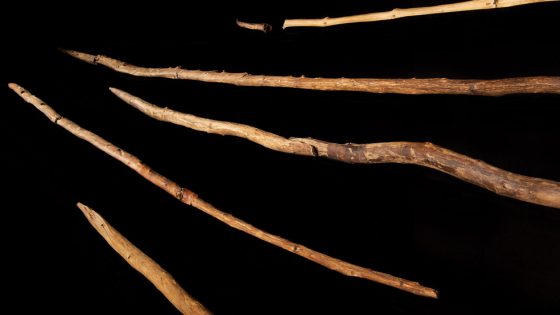In 1836, Christian Jürgensen Thomsen, a Danish antiquarian, brought the first semblance of order to prehistory, suggesting that the early hominids of Europe had gone through three stages of technological development that were reflected in the production of tools. The basic chronology — Stone Age to Bronze Age to Iron Age — now underpins the archaeology of most of the Old World (and cartoons like “The Flintstones” and “The Croods”).
Thomsen could well have substituted Wood Age for Stone Age, according to Thomas Terberger, an archaeologist and head of research at the Department of Cultural Heritage of Lower Saxony, in Germany.
“We can probably assume that wooden tools have been around just as long as stone ones, that is, two and a half or three million years,“ he said. “But since wood deteriorates and rarely survives, preservation bias distorts our view of antiquity.” Primitive stone implements have traditionally characterized the Lower Paleolithic period, which lasted from about 2.7 million years ago to 200,000 years ago. Of the thousands of archaeological sites that can be traced to the era, wood has been recovered from fewer than 10.
Dr. Terberger was team leader of a study published last month in the Proceedings of the National Academy of Sciences that provided the first comprehensive report on the wooden objects excavated from 1994 to 2008 in the peat of an open-pit coal mine near Schöningen, in northern Germany. The rich haul included two dozen complete or fragmented spears (each about as tall as an N.B.A. center) and double-pointed throwing sticks (half the length of a pool cue) but no hominid bones. The objects date from the end of a warm interglacial period 300,000 years ago, about when early Neanderthals were supplanting Homo heidelbergensis, their immediate predecessors in Europe. The projectiles unearthed at the Schöningen site, known as Spear Horizon, are considered the oldest preserved hunting weapons.
In the mid-1990s, the discovery of three of the spears — along with stone tools and the butchered remains of 10 wild horses — upended prevailing ideas about the intelligence, social interaction and toolmaking skills of our extinct human ancestors. At the time, the scientific consensus was that humans were simple scavengers who lived hand-to-mouth until about 40,000 years ago.
“It turned out that these pre-Homo sapiens had fashioned tools and weapons to hunt big game,” Dr. Terberger said. “Not only did they communicate together to topple prey, but they were sophisticated enough to organize the butchering and roasting.”
The new study, which began in 2021, examined more than 700 pieces of wood from the Spear Horizon, many of which had spent the previous two decades stored in chilled tubs of distilled water to simulate the waterlogged sediment that had protected them from decay. With the aid of 3-D microscopy and micro-CT scanners that highlighted signs of wear or cut marks, researchers identified 187 pieces of wood that showed evidence of splitting, scraping or abrasion.
“Until now, splitting wood was thought to have been only practiced by modern humans,” said Dirk Leder, an archaeologist also at Lower Saxony and lead author of the paper.
Besides weapons, the assemblage included 35 pointed and rounded artifacts that were most likely used in domestic activities such as punching holes and smoothing hides. All were carved from spruce, pine or larch — “woods that are both hard and flexible,” said Annemieke Milks, an anthropologist from the University of Reading who collaborated on the project.
Since neither spruce nor pine would have been available at the lakeshore, where the site was located, the research team deduced that the trees had been felled on a mountain two or three miles away or perhaps even farther. Close inspection of the spears indicated that the Stone Agers planned their woodworking projects carefully, following a set order: strip the bark, remove the branches, sharpen the spear head, harden the wood in fire. “The wooden tools had a higher level of technological complexity than we usually see in stone tools from that age,” Dr. Leder said.
Francesco d’Errico, an archaeologist at University of Bordeaux who was not involved in the study, praised its insights into the methods and materials that Stone Age people used to solve practical Stone Age problems. “The paper opens a window into the almost unknown world of the Lower Paleolithic,” he said. “In spite of the paucity of data, the authors make a courageous attempt to propose a scenario for the evolution of such technology that needs to be tested in the future against new discoveries.”
Perhaps the most surprising revelation is that some of the spear points were resharpened after earlier breakage or dulling, and that some of the broken weapons had been whittled down, polished and repurposed. “The wood that we identified as working debris suggested that tools were repaired and recycled into new tools for other tasks,” Dr. Milks said.
All but one of the spears were hewed from the trunks of slow-growing spruce trees and shaped and balanced like modern javelins, with the center of gravity in the middle of the shaf. But were they meant for throwing, or for thrusting? “The spears were made from dense wood and with thick diameters,” Dr. Milks said. “To me, that suggests the hominids manufacturing them may have intentionally designed at least some as flight weapons for hunting.”
She tested the spears’ external ballistics by enlisting six trained male javelin throwers, aged 18 to 34, to heave replicas at hay bales from various distances. “My point was to ask people who were a little bit better at doing this than archaeologists, because up until that point, we’d had experiments with lots of people who were … archaeologists,” Dr. Milks said, adding: “Anthropologists are not very good at that kind of thing, either.”
From 33 feet away, Team Neanderthals hit the target 25 percent of the time. The athletes were equally accurate at 50 feet, and only slightly less (17 percent) at 65 feet. “Still, that was double the range at which scientists had estimated a hand-thrown spear could be useful for hunting,” Dr. Milks said.
For her, the notion that our Stone Age forebears were artisans serves to humanize them. “Working wood is slow, even if you’re good at it,” she said. “There are lots of different steps in the process.” She imagines a bunch of Neanderthals clustered around an evening campfire, assembling and sanding and mending their wooden handicrafts. “It all seems very, very close, in a way,” she said, wistfully, “even though it was such a long, long time ago.”
Source Agencies



